Showers are usually the go-to for luxurious baths for most people, but the bathing options presented with a bathtub are always nice to have. Especially for households with younger children and pets, a bathtub seems to have its place and purpose for a growing family. Furthermore, full body baths in warm water are an undeniably great way to relax and rejuvenate the body. Although bathtubs may have fairly similar uses and functions, there are many types of bathtubs with varying sizes and forms. Since each type of bathtub can offer a unique set of features and bathing experiences, it can be somewhat confusing to identify which bathtub is which and what they offer. To make things easier, we outlined in this article the different types of bathtubs and their features.
6 Most Common Types of Bathtubs
1. Freestanding Bathtubs
Freestanding bathtubs are generally easy to spot since they can easily stand out in a bathroom design. They are easily distinguishable given that they are unattached and can come in unique sizes and shapes. These bathtubs are visually striking and offer many ways of impacting the overall bathroom design and layout. Given the freestanding form, these bathtubs can be positioned in creative ways throughout a bathroom like on the side as a corresponding piece or in the center as the main attraction and centerpiece. Also, accentuating the freestanding bathtub with chrome or metal faucets can work wonders for achieving a modern and elegant aesthetic appeal.
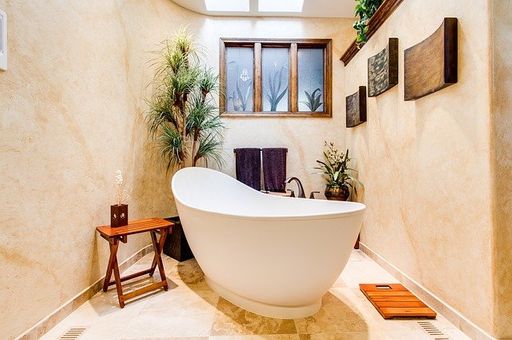
Types of Freestanding Bathtubs
Not surprisingly, there are a few kinds of freestanding bathtubs and including the modern base freestanding tub, claw-footed freestanding tub, alcove freestanding tub, and the round freestanding tub.
- Modern Base Freestanding Bathtub: a generic bathtub with a simple and modernly minimalistic design.
- Claw-foot Freestanding Bathtub: the tub is clawed and extended towards the feet, which offers functionality and a uniquely elegant form.
- Alcove Freestanding Bathtub: a regular freestanding bathtub that is positioned in an alcove or small space in the bathroom.
- Round Freestanding Bathtub: the tub is fully or mostly round like a bowl.
Pros:
- Elegant and engaging visual appeal with modern design
- Versatile and functional appeal
- Flexible positioning at the side or center of the bathroom
- Easily visible and prominent
Cons:
- The deep tub with high walls may be impractical for young children and the elderly
- Very heavy and requires a stable enough floor for support
- Prices can be expensive
2. Hot Tub
Recognized as the ideal tub for relaxingly warm and delightful baths, hot tubs offer some of the best bathing experiences for rejuvenating and renewing the body. Given their heavenly appeal, hot tubs are usually associated with luxurious elements like a bathroom with marble flooring, tiled walls, and wide windows. For generating that blissfully warm water temperature, hot tubs are usually built with integrated air jet systems.
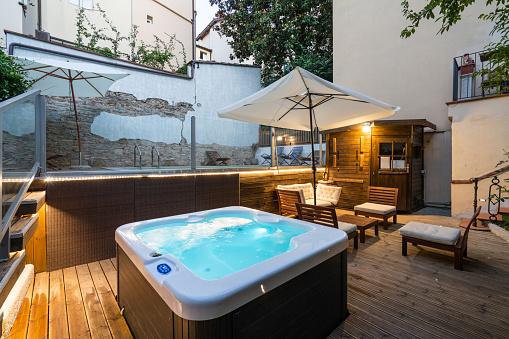
Pros:
- Heavenly full body baths and deep-soaking
- Perfect for relaxation and enjoyment
- Can be used for hydrotherapy
Cons:
- Expensive
3. Alcove Bathtub
Alcove bathtubs come with a practical design given that they are attached to three walls in an alcove. The practical layout ensures the tub is effectively functional and convenient for use. Since alcove bathtubs are attached to the walls, a shower head is usually found above one of the connected walls. The alcove bathtub design is ideal for bathrooms with limited space since it efficiently makes use of tight corners and alcoves. Alcove bathtubs prove to be highly convenient and space efficient, which is why they are found in many modern bathrooms. Given the standard setup that comes with alcove bathtubs, they can come as simple alcove bathtubs, luxury alcove tubs, and everything else in between.
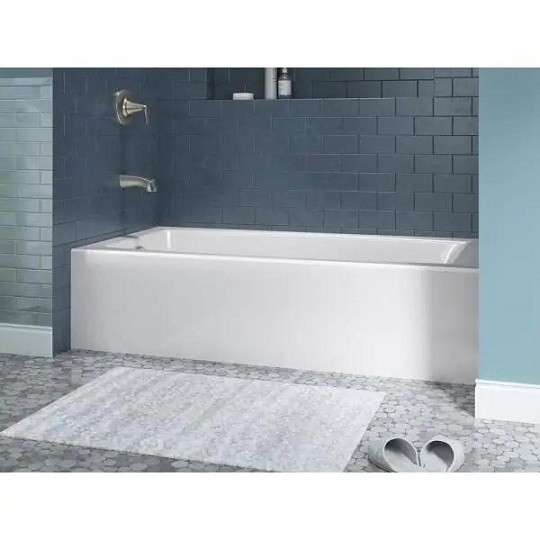
Pros:
- Highly functional and practical
- Easy to decorate and style
- Undemanding maintenance
- Reasonably affordable
- Versatile across all price points
Cons:
- Requires an alcove or similarly tight spaces
4. Walk-in Bathtub
A walk-in bathtub is designed for those with movement issues and disabilities. Walk-in bathtubs come with a built-in door on the side to make it easier for entering and exiting the bathtub. Other additional features found on walk-in bathtubs can include things such as hydro-massaging systems and safety handlebars. For added convenience and function, walk-in bathtubs can be installed along with a shower head.
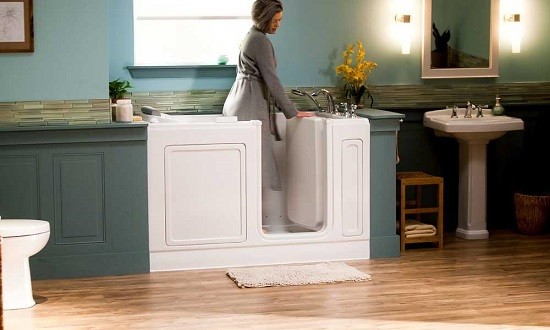
Pros:
- Perfect for the elderly and people with movement issues
- Safe and effectively efficient design
- May include additional features
Cons:
- The tub must be drained before opening the side door
5. Drop-in Bathtubs
Unlike alcove bathtubs, the drop-in bathtub can be surrounded and attached to the walls, flooring, or directly to the floor. Drop-in bathtubs are versatile in design since they generally have numerous options when it comes to the surrounding unfinished sides, which leave much room for customizability. Drop-in bathtubs can be mounted into a deck or platform, and retain the built-in drop-in design. In addition to the customizable tub design, walk-in tubs are perfect for creating custom tub deck designs for a glamourous surrounding mount. Given their design versatility and layout customizability, drop-in bathtubs can come in several types including the standard drop-in bathtub, corner built-in bathtub, and step-up drop-in bathtub.
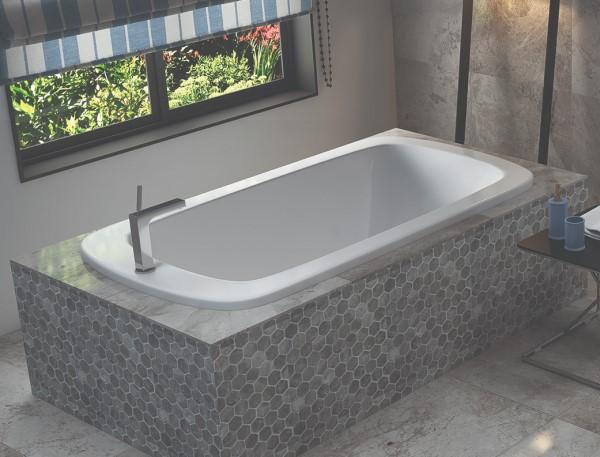
Types of Drop-in Bathtubs
- Standard Drop-in Bathtub: standard drop-in bathtub that is built into the walls, floor, or mounted deck/ platform
- Corner Built-in Bathtub: bathtub shapes vary for corner bathtubs since they are built into a corner as either a rectangle or triangle depending on the allotted space.
- Step-up Drop-in Bathtub: the drop-in bathtub surrounding platform or mount comes with a small step/s for entering and exiting the tub
Pros:
- Luxurious appeal
- Versatile design
- Customizable layout
- The elegant and functional form
Cons:
- Somewhat elaborate installation
- Can be difficult to enter and exit the tub due to the deep tub
Type of Bathtubs Materials
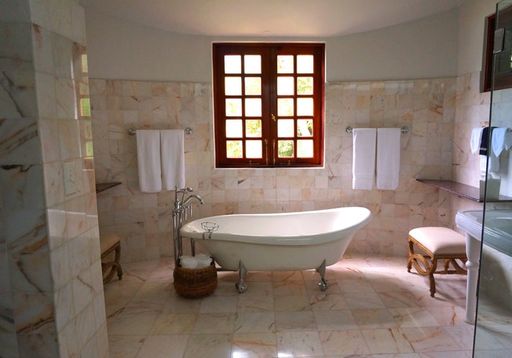
Bathtubs can be constructed from a variety of different materials with most modern ones made from porcelain-enameled steel, porcelain-enameled cast iron, fiberglass-reinforced polyester, and thermoformed acrylic. Although materials can vary, the types of bathtub installation do not differ too much and are mostly similar despite the material used.
- Porcelain-enameled cast iron is a contemporary and classic material found in most modern bathtubs and is durable and long-lasting. Due to the sturdy material weighing a lot, it requires a strong enough floor to support its heavy weight. Also, bathtubs made from porcelain tend to be steel-based, which results in a low-maintenance, cost-effective, durable, and matte finish.
- Acrylic and fiberglass-based bathtubs come with a highly durable and notably glossy surface. Also, tubs made from acrylic tend to be designed as walk-ins or soaking bathtubs, which are also quite affordable.
- Cast polymer bathtubs are effectively durable, sturdy, and resistant to stains and scratches. Furthermore, the material allows bathtubs to be designed in numerous shapes, colors, and bath styles.
Conclusion
The different types of bathtubs can vary depending on size, shape, positioning, and purpose, but their general bathing function remains the same regardless. Bathtub designs are not limited to the bathtub itself, but also their material composition and installation, which is what effectively distinguishes each type from one another. Given the different variations of bathtubs, a handful of the general types of baths like the ones mentioned above will make it easier to identify just about any modern bathtub.
0 Comments for “Guide to Different Types of Bathtubs in the Market”